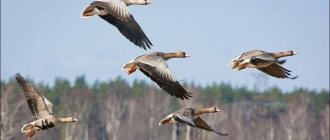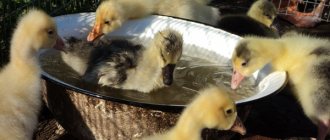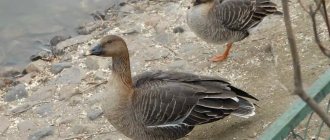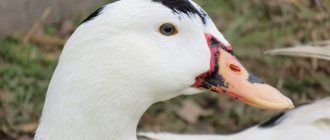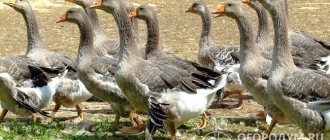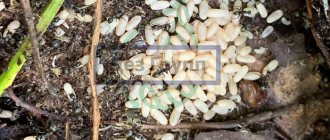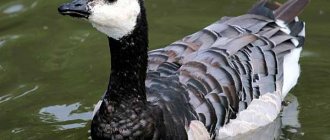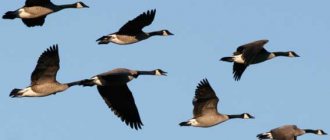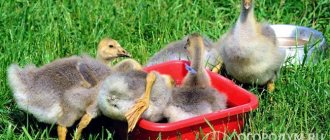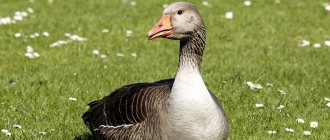Autumn goose hunting
Goose hunting occupies an important place for real hunters. A wild goose is valuable for a hunter, not only because of its considerable weight and tasty meat, but also because it is a very smart bird that is very difficult to deceive and therefore the hunting process is doubly interesting.
Wild geese are not the easiest opponents. They are well organized, extremely careful, travel thousands of kilometers, constantly facing all sorts of threats. Therefore, a hunted goose is a valuable trophy for any hunter.
Geese are part of the duck family. Ducks and swans belong to the same family. There are several species of wild geese found in Russia:
- Grey goose. The nesting grounds of the gray goose are located in the floodplains of rivers. This subspecies is found not only in Russia, but also in Northern and Central Europe. The gray goose is common on the Kola Peninsula, in the Northern Dvina region, and the upper reaches of the Volga. This bird is widespread in Siberia - from the middle reaches of the Yenisei and Ob to Altai. The gray goose winters in Central Asia, the Balkan Peninsula, and North Africa.
- Bean goose
.
Breeds in tundra and forest-tundra. The bean goose winters in the Mediterranean and Black Seas, China and Japan. - White-fronted goose
.
Habitat: tundra. The white-fronted goose nests there. Wintering takes place in Japan, India, and China.
There are several other breeds of geese found in Russia. They are rare and have no commercial significance.
The morphology of different breeds of geese differs, as do their priorities when choosing a habitat. However, the methods of hunting for all species are approximately the same. The only difference is in the direction of flight and the places of fattening.
All subspecies of geese are herbivorous. They eat algae, foliage of aquatic plants, terrestrial grasses, and fruits. A young goose finds food in a swamp, spring flood, or oxbow lake. There are plenty of insects, crustaceans and protozoa there. Areas with an abundance of small lakes are especially rich in food.
Adult geese are less attracted to water bodies, finding food in other places. Fields and meadows provide them with equally abundant food. Plots of cultivated agricultural land are especially attractive to geese.
Behavior of geese in autumn
Flight routes
The migration of geese to their winter habitat occurs along the Arctic coast, through the Karelian Peninsula - to Southern Europe and North Africa. Major migration routes run through the Urals, Kalmykia, Kazakhstan - to the Mediterranean. Siberian routes go through Kazakhstan, Altai, and Buryatia. The main flow of birds occurs along the migration route. The farther you are from the main routes, the less common wild geese are.
Regions such as Moscow, Vladimir or Nizhny Novgorod are located away from migration routes. In the Yaroslavl region, Bashkiria, and Tatarstan, there are much more wild geese during the migration period. The predicted hunting is typical for the Leningrad, Orenburg and Arkhangelsk regions, Karelia, Kalmykia, and Stavropol. This does not mean that hunting a goose in these regions is easy, but due to the abundance of migratory birds, the chances of a successful hunt increase significantly.
A flock of geese can fly up to a thousand kilometers per day. After such long flights, she always stops to rest and refresh herself, so that she can then continue the journey.
Migration Features
The autumn migration of geese is a flight from nesting grounds to wintering grounds. The flight distance is determined by the strength of the wind. If it is strong, the birds are forced to shorten their route. The ideal wind direction for geese is north or northeast (that is, tailwind). In such conditions, birds can fly more than a thousand kilometers in a day without landing to rest or feed.
However, ideal circumstances are rare. Geese fly all over the country, and the weather in different regions is often radically different. Therefore, deviations from the route and delays are inevitable.
Geese always fly in flocks. One group follows another. When there are many flocks in the air at the same time, hunters say “a wave has begun.” Its passage lasts for several days - from 2 to 7 days. However, such waves occur only on the path of mass migration. At some distance from it, even a flock of 200–300 birds is considered large.
Rules for successful goose hunting
Goose hunting must
take place in conditions that guarantee the possibility of a normal shot, which means that its organization must be approached very responsibly. The advice given below is intended for hunters who hunt for themselves. Our fauna is dominated by three species of geese - greylag, bean goose and white-fronted. These are large birds, and by the general name “geese” we will mean them. It is necessary to immediately make a reservation that, having only 2-3 days for hunting, it is hardly worth counting on success in an unfamiliar area. Because success in this hunt must always be preceded by at least a short but obligatory period of observation of the behavior, feeding and resting places, as well as flight routes of flocks of geese. The nature of our country is very diverse; the intensity of flight of geese and the characteristics of their behavior during this period directly depend on climatic conditions, landscape and other characteristics of a particular region. Naturally, approaches to organizing hunting may be different, although there will certainly be certain similarities between them. The spring migration in the European part of Russia, as a rule, is more extended in time than the autumn one, but short hunting periods do not always allow one to reach its peak. However, the presence of 3-4 lingering flocks in the area of the intended hunt gives an opportunity to count on success. In the fall, geese stop for a long rest less often, but they still stop, and a hunter who finds himself in such a place should try to arrange an interesting hunt for himself.
Choosing a place to hunt a goose
During migration, geese choose a place for a long break along the way based on three main characteristics: a sufficient number of fields where grain was harvested in the fall or winter crops sprouted; It is necessary to have a quiet place, hard to reach for people, for day and night rest and minimal disturbance during feeding and flights. You need to start preparing for the hunt with your own observations or interviewing local residents to find out in which fields the geese feed. When a field or group of such fields is identified, be sure to walk through them and, based on the presence of tracks, droppings, feathers, find out the most visited areas and start hunting in these places. There is one feature in geese visiting fields that makes it easier for an attentive hunter to determine the place of the flock's morning feeding. If in the afternoon, closer to sunset, you notice birds sitting on a field, you need to watch them before leaving for the night's rest, and if no one scared them off, and they left the field in a “natural” way, then there is a very high chance that this flock will In the morning he will continue feeding in this very place. So, that’s where we’ll make a stop.
There are four ways to hunt a goose:
1. In the fields or “fat areas”. They fly to harvested fields, large swamps, and usually early in the morning to feed. They can stay there for a week. It is almost impossible to hunt a goose from the approach, so the hunter is positioned in advance at the place where the birds arrive. He digs a skradok, hides there and waits for the birds with a gun.
2. In their daytime rest areas. Because during migration, geese stick to large rivers, so during rest they sit on sand spits with low and sparse vegetation. Landing sites can also be determined by the colonies of seagulls located there. As a rule, such stopping places for geese are the same every year. You can hunt there all day long, because they swoop in at any time.
3. Hunting in places where you spend the night. As already mentioned, geese stop in open places and roosting areas are no exception. They have areas where they fly to feed, and there are places where they spend the night, but they arrive there after dark. In this case, you should not come too close to such places, because you can scare away the flock, and it will never fly here again. It makes sense to hunt in the dark on moonlit nights, when the area is clearly visible, so that when the geese arrive to roost for the night, you can make a targeted shot.
4. Hunting by drive. This is primarily a collective hunt, at least two people. To do this, you need to place scarecrows that will lure geese to a certain area. One person or shooter needs to stay in this area and wait for the geese to arrive, while the second person carefully and unobtrusively “pushes” the geese so that they fly to this area convenient for the hunter.
Fresh, 2022 maps of flights of geese wintering in the Netherlands and Germany:
Migration tracks of wild goose wintering in the Netherlands and Germany:
- Femma_3099 Track
- Bar_L6R-_2017 Track
- Bar_L6R=_2017 Track
- Bar_L6RE_2017 Track
- Bar_L6R2_2017 Track
- Bar_L6R4_2017 Track
- Bar_L6R6_2017 Track
- Bar_WTN1_2017 Track
- Bar_L6R8_2017 Track
- Bar_L5R6_2017 Track
- Bar_L4R1_2017 Track
- Bar_L4R2_2017 Track
- Bar_L4R4_2017 Track
- Bar_WTNP_2017 Track
- Bar_WVNE_2017 Track
- Bar_L4R9_2017 Track
- Bar_WVN9_2017 Track
- Bar_WVNK_2017 Track
- Bar_WVNU_2017 Track
- Bar_Y1N3_2017 Track
- Bar_Y1N5_2017 Track
- 43_AdrieII_M Track
- 52_EvertII_M Track
- 58_WouterII_M Track
All geese migration routes 2022 on one map:
All migration routes of geese on one map (On the left, select a goose with a transmitter, below are the dates!
, so that the tracks are visible.)
Birds have been ringed for scientific purposes for over 100 years. Traditionally, metal rings were used with numbers and the name of the ringing organization engraved on them. Thanks to ringing, it was possible to learn a lot about the directions and migration routes of birds and the features of their ecology. Unfortunately, the metal ring becomes informative only when the bird can be held in your hands. In most cases, these are already dead birds; Thus, information about banded geese comes mainly from hunters. Occasionally you manage to catch a ringed bird, or read the ring number from a short distance. We will never know the fate of the vast majority of birds ringed with metal rings. Due to the fact that the return rate of metal rings is extremely low, specialists began to use colored tags. Geese are usually marked with colored leg rings and collars, the numbers of which can be read by examining the bird through binoculars, even from a great distance. To mark birds of other species, wing marks and other colored marks are used.
In addition, radio and satellite transmitters are now used to study bird migrations; However, the satellite tracking method is very expensive, and radio tracking requires significant effort and time.
Unfortunately, this kind of tracking of geese migration is short-lived. Many geese die of natural causes, some are shot by a hunter. If you come across a goose with a GPS transmitter, please inform the owner of the transmitter. The coordinates are usually indicated on the transmitter itself or on the website blessgans.de or geese.org. This will help study and preserve the world's wild geese population. Some unscrupulous hunters keep transmitters as souvenirs or try to sell them to their owners. For example, a “goose” nesting in a five-story building in Perovo in Moscow
- Rolf_3272_KY6 Track
- Mari_3269_KY4 Track
Well, Diana is their judge. You can't fool karma
We remind you
- Goose hunting in Ukraine is still prohibited in 2022
- Never shoot at marked birds so that it can work for future generations.
- Sightings of tagged geese can be reported online at geese.org
- Orange collars in the spring waves of geese migration are German, yellow collars are Japanese and Italian.
Last year, we already offered our readers a service for tracking the migration of migratory goose on-line. If anyone is not yet familiar with our materials and became our reader this year, we will briefly remind you of the main things last year, and then we will post the data on this year’s goose flight. So, we offer to the attention of all goose hunters
.
We decided to give our readers the opportunity to learn how to track the migration of waves of migratory goose without leaving the computer.
Today we will teach you how to track your favorite hunting object directly from your monitor screen around the world. With our help, you can track the flight of geese using data from two geopositioning control systems at once.
If you click, for example, on the picture below, you will see a standard example of the migration route of a bean goose named Adri.
In autumn it flies through the Tula region, and in the spring - through the Tver region. But this does not mean that other waves of migratory goose do not exist. There are quite a lot of them, so we will put in your hands a whole mechanism for tracking waves of geese migration.
One request - so that this can work for future generations - do not shoot marked birds. Orange collars in the spring waves of geese migration are German, yellow collars are Japanese and Italian. Please let us know about any collars you see.
In real time, the flight map of a particular goose looks like this:
The use of satellite transmitters opens up new prospects for a detailed study of geese migrations, because until recently our knowledge about the flight paths of birds and their stopping places during long-distance migration from wintering sites to nesting areas in the Arctic was far from complete.
Small backpacks containing satellite transmitters draw intricate lines on maps that can be viewed online. It turned out that the geese traveled from wintering sites to nesting sites in different ways, sometimes quite unexpected for researchers. The transmitters are still in operation, transmitting data on the location of the geese every day. This data is constantly plotted on maps, which can be viewed on websites in our review, published in the section.
However, tracking a goose is not the only point in the long line of skills of the modern hunter. Within a month, in the article feed you will be able to find a series of articles on goose hunting and a monograph on geese.
Modern technologies make it possible to monitor the migration of geese in real time. Bird tracking using GPS navigation has been carried out by many organizations around the world for several years.
The most comprehensive and successful project tracks the migrations of a goose that...winters in Western Europeblessgans.de. This German site gives its visitors the opportunity to follow goose migration through the traditional Google Earth service.
The migration of our goose, wintering in Egypt, can be tracked on this site; some specimens already set off last year and reinforced themselves in Turkey (as of March 16, 2009).
However, we will teach you how to accurately track a goose to select the location and time of hunting using the world's most advanced Google Earth service.
Of course, this service is not intended for hunters at all, but, on the contrary, for scientists and wildlife defenders. But access is not denied to anyone, and therefore we will simply provide you with the opportunity not to waste your money and time.
So. First you need to install on your computer or the free version of Google Earth,
which can be downloaded from the
Google page:
https://earth.google.com/intl/ru/
The whole world is open before you!
However, now there are many not entirely licensed offers on the Internet, so we, without having this material on our website ourselves, provide a link to information posted on the Internet by third parties. Please note that in accordance with the Law, after reviewing it, you must erase this information from your computer. The material is not provided for distribution and for non-commercial purposes.
Google Earth Pro Final With license Key 4.3.7191.6508
- Google Earth can take you anywhere on earth to view maps, satellite images, landscapes and 3D buildings, and even provides opportunities to explore galaxies and starry skies. You can explore geographic content, save an overview of places, and share information with other users.
Peculiarities:
Google Earth Pro makes it easy to explore geographic features and display the data you find. With a few clicks, you can import site plans, property listings, or client locations and share the view with your client or colleague. Moreover, you can export high-quality images to documents or the Internet. Want to see how the program works? Free trial for 7 days.
Operating system:
Windows® 2000/XP/Vista
Interface language:
Russian
Size:
30 MB
Medicine:
Present (This technique is for demonstration and the responsibility for its use lies with the user).
DOWNLOAD DOWNLOAD
Let's try to figure out how geese fly through Belarus in the spring. And let’s do this using the example of the most numerous species – the white-fronted goose.
Weapon Selection
Semi-automatic shotguns
The semi-automatic shotgun category is especially popular among hunters. The reason for this is the ability to fire quickly. Shotguns are equipped with magazines for cartridges.
It is difficult to choose a semi-automatic gun for goose hunting. Semi-automatics suffer from destruction of the rear wall of the box and weak shock absorbers. However, there are several models with a 70mm chamber that are most suitable for goose hunting. Among them it is worth highlighting Browning Auto-5, models MC 21-12, TOZ-87.
Among the models with a 76 mm chamber, the MP-153 shotgun (with a standard barrel constriction of 0.75 or 1.0) is suitable for goose hunting. It should be borne in mind that choke tubes significantly impair shooting efficiency.
The Beretta AL 390, Beretta AL391 Urika Sporting and Remington 1100 are of high quality. However, the 1100 model is heavy (up to 3.7 kg), so it is not suitable for every hunter. The Remington is equipped with a one-piece receiver, as well as an adjustable automatic gas outlet.
Double-barreled shotguns
This type of weapon has been used for a long time, when semi-automatic weapons were not yet produced. Among double-barreled models, the popular brands are IZH: 26, 12 and 54. The models, although outdated, are very reliable.
Currently, more advanced guns are produced, for example, IZH-27M-M and IZH-39T. The MTs models 200, 109, 111 and 108 have proven well for goose hunting. However, the MCs are expensive, so they are not very common.
What is known from the literature?
At the end of the last century, visual census data were published. In the article “Features of migration of waterbirds in Belarus,” the spring migration of geese is described as follows:
“In spring, most geese migrate in east and northeast directions. In this case, a certain pattern in the direction of flight is observed. Thus, in the southern part of Belarus the eastern direction predominates, which coincides with the location of the Pripyat riverbed from west to east. The vast majority of geese fly to the east in this zone: 82.7% in Belovezhskaya Pushcha, 87.1% in the Pripyat floodplain (Pripyatsky Nature Reserve). In the south-eastern point of Belarus (the territory adjacent to the Chernobyl nuclear power plant), where the river bed. Pripyat turns to the southeast, only 20% of geese continue to adhere to the Pripyat floodplain, 34% flies further to the east, and the majority - 42% - turns to the northeast.
In the central part of the republic, most geese migrate in a northeast direction. Thus, in the floodplain of the Neman River, which flows from southeast to northwest, the main direction of flight of geese was northeast (58%) and east (25%). In the vicinity of Minsk, the eastern direction predominated (52.8% of recorded birds), 24.2% flew to the southeast and 20.3% to the northeast. In the floodplain of the river. On the Berezina River, most geese migrate in a north-easterly direction (49%).”
Thus, in spring the general direction of movement of migrating geese is from west to east.
Satellite data
Modern technologies make it possible to monitor the migration of geese in real time. Bird tracking using GPS navigation has been carried out by many organizations around the world for several years. The most comprehensive and successful project tracks the migrations of geese wintering in Western Europe. The German website blessgans.de provides its visitors with the opportunity to monitor goose migration through the traditional Google Earth service.
Some geese wintering in Western Europe fly north of Belarus in the spring. One of the main spring gathering places for geese migrating through this region is the Neman River delta. Next, the birds fly to nesting sites located in the tundra of the European North of Russia.
Another part of the geese flies through Belarus in the spring. We can say that she is less fortunate, because in the spring our birds do not receive a warm welcome at all.
Practical advice
- Most of the unsuccessful shots occur when aiming “accurately at the target”. For accuracy, it is recommended to maintain a lead when shooting (that is, the aiming point is slightly in front of the goose). Maintaining clearance (while holding the weapon in front of the target), they fire a shot. This method of shooting is called “shooting with eyeliner”.
- There is a rule: you need to shoot not at the nearest goose, but at a distant one, but one that is within striking distance. The next shot will hit a nearby bird, allowing you to complete a doublet. Particularly successful hunters even make triplets.
- Coordination is important when hunting. Coordinated action is important not only for effective shooting, but also from a safety point of view. Therefore, you need to agree in advance on which side the shooting will take place from.
- It is better to use a shot with a lower number, but a more compact strike.
- When arranging decoys, it is recommended to evaluate the distances on the future shooting field. Some hunters make marks. Hummocks, bushes, etc. can act as landmarks.
Goose hunting is an exciting activity. A trophy obtained in such a hunt is not so much luck as it is the qualifications of the hunter, knowledge of the habits of the bird and the correct organization of the event.
And lastly, information from our Bird Banding Center
We currently have information from more than two hundred ringed birds. The average age of white-fronted geese harvested is more than three years (1046 days). The maximum age recorded from banding data is over 22 years. However, given the fact that the adult bird was ringed, its age was at least 24 years.
Based on the information received from ringed birds, it can be stated that the main wintering grounds of white-fronted geese migrating through Belarus are in Western Europe (the Netherlands, Germany, England). In 139 of 143 cases they were ringed in the Netherlands.
Information from the places where birds flying through the territory of Belarus nest is scarce, but according to available data, it can be said that the nesting area of white-fronted geese extends from the White Sea coast to at least Taimyr.
Preparing for the hunt
Even before the hunt begins, you need to take care of its proper organization. We are talking about preparing decoy stuffed geese, decoys, camouflage and concealment.
Stuffed animals and profiles
Profiles and stuffed animals are used to lure wild geese. The first option is an inexpensive bait method, which is an image of a bird on plywood. However, the effectiveness of profiles is inferior to full-bodied stuffed animals.
The main requirement for a bait is a realistic appearance. It should be as similar as possible to a live goose. We are talking not only about the shape of the stuffed animal, but also about the absence of such defects as glare, movement under the influence of wind. Stuffed animals should have natural and varied poses: some of them imitate feeding geese, and some of them stand guard.
Stuffed animals are divided into the following types:
- Volumetric non-separable models.
- Collapsible dummies. The body and head of the goose need to be connected independently. It is also possible to change the tilt of the head.
- Semi-profile models, where the models are distinguished by voluminous necks and heads, and the torso is flat.
- Batch. They are inflatable dummies.
Hunter's Clothes
The hunter must have warm and comfortable clothes and waterproof shoes. Waiting for a long time in ambush in equipment unsuitable for this is fraught with colds. It is also recommended to purchase or make mats yourself (preferably polyurethane). They will additionally protect your feet from dampness.
Camouflage for hunting is selected based on the surrounding landscape. The best clothing color for fall is yellowish. Clothes with washed out colors are also suitable. In addition to clothing, capes and camouflage suits serve as camouflage.
Skradok for hunting
Hide areas (the place where the hunters are) are organized in bright areas. Geese have good eyesight, but they see poorly against the sun, which is why they fly around dark areas of the terrain. In this regard, it is impossible to create concealments in ravines or ditches. It is recommended to camouflage the pit with plants native to the area.
There are two ways to organize a secret:
- Dig a hole measuring one by two meters. The excavated soil is laid out as a parapet along the edges of the pit. Cardboard boxes are used to cover the hole. The color of the cardboard resembles sand, which is good from a camouflage point of view. The cardboard is laid in three strips. The first covers the legs to the waist. The second is cut into two parts, the edges are dug into the ground, resulting in something like doors for the hunter hiding behind them. The third stripe covers the hunter's head.
- They also dig a hole. A horizontal cover is installed in it, covered with burlap. The result is something reminiscent of an American factory-made secret.
Attracting Geese
Decoys—special devices that imitate the natural voices of birds and animals—are of great importance for attracting wild geese. Hunters use a decoy to lure the flock towards them. Moreover, different types of geese make different sounds, and therefore each breed requires a special decoy.
One decoy is not enough for serious hunting. With several decoys, the illusion of not just one bird, but a whole group is created.
Below are homemade and industrially produced decoys.
Electronic decoy
Homemade semolina diagram
Homemade decoy
Industrial decoy
There is a wide variety of decoys on the market, so it is easy to choose the right model for the appropriate breed of goose. Acrylic decoys produce the loudest sound. However, wooden models have the most natural, soft sound. It’s easy to make a decoy yourself. Usually bones or cartridge cases are used for this.
To learn how to call correctly, you need to observe the natural behavior of a wild goose. There is a difference between the sounds a goose makes when feeding, when approaching, on the water or during a long flight. Sounds differ in tonality, pitch and power. It will take some time to learn how to use a decoy, usually 1–2 weeks.
